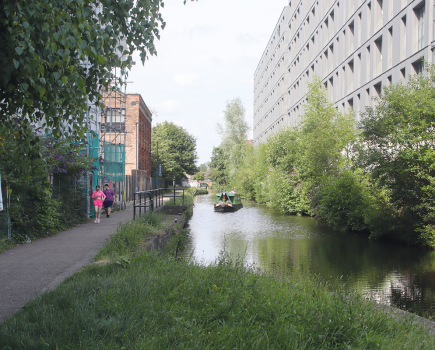History of Locks
Words and images: Anthony Burton
The story of canal and river locks goes back a long way. The first attempts to control rivers involved millers, not boatmen. They built weirs to establish a good head of water that could then be diverted down leats to turn their wheels. But these formed obstacles to boats and were greatly resented by men such as the waterman poet, John Taylor. Describing a trip down the Thames in the early 17th Century he wrote of one spot:
Haules Weare doth almost crosse the river allMaking the passage straight and very small.How can that man be counted a good liverThat for his private use will stop a river?
By fitting the weirs with moveable paddles, they could be transformed into flash locks. The deep water above the weir would be released in a rush and boats would ride down on the flood or flash, or be winched up against the current. Canals, like rivers, have to manage changes in level, but their waters are essentially still, so a very different system has to be used. And the development of canal locks goes back a long way before the start of Britain’s canal age.
The main centre for canal development in medieval Europe was the Netherlands, where the system of drainage dykes was also used for transport. Simple sluices were built to control the water flow from river to dyke. The earliest forms had what were known as portcullis gates – so-called because, like a portcullis that closed off the entrance to a castle, the gates were raised and lowered vertically. It was soon realised that by opening and closing the sluices, levels in dyke and river could be equalised, allowing boats to pass from one to the other. They could also be used as primitive tidal locks, linking canals and estuaries. As the structures got larger, the abutments were often extended out into the river and the foundations secured by piling. The pile driver was probably the first machine to be used in canal construction. The earliest versions worked a bit like the later guillotines. A weight was raised in a vertical frame by means of a crank, and then allowed to drop down under gravity.
At some time in the 14th Century it was realised that a rather more efficient type of tide lock could be introduced by putting two portcullis locks close together – creating a simple enclosed chamber, or pound, in between. It made it much easier to transfer boats between the canal basin and the tideway. The next obvious step was to apply the same idea to make a convenient step in a river, instead of having to rely on the dangerous flash locks. A 15th Century illustration shows two portcullis locks, simply placed across the whole river. There does not appear to have been any attempt to create a lock chamber; the space between the two gates is contained within the natural river banks. A lock of this type was described by Leone Battista Alberti in a manual on canal construction that was published in 1485, and which had the two locks set apart at a distance equal to the length of the boats using the waterway. This could be seen as the forerunner of the modern lock.
This all represented real progress, but portcullis locks are cumbersome and require a great deal of hard work to lift. The obvious answer would be to have a gate that opened horizontally, but if it was too big that too would be difficult to move. That problem could be solved by closing the gap with a pair of gates meeting in the middle. The trouble with that idea was how to stop them being pushed open by the weight of water. The answer was provided by the renaissance genius Leonardo da Vinci. He had been appointed ducal engineer of Milan in 1482, and ten years later he was designing locks for the Naviglio Interno. He realised that if you arranged the gates so that they met at an angle, like a mitre joint in woodwork, the weight of water, instead of pushing them apart would actually force them closer together. The space between the gates was strengthened with masonry, essentially making this the first modern pound lock.
The new design spread across Europe and reached Britain in the 16th Century. The Countess Wear had been built across the River Exe at Exeter in the late 13th Century. It effectively formed a barrier to ships, preventing them reaching the centre of the city. This was good news for the citizens of Topsham, who got all the trade, but very inconvenient for the merchants of Exeter. The latter decided to pay for a canal that would allow ships to bypass the weir and reach a new port complex near the centre of the city. The engineer for the Exeter Ship Canal, begun in 1564, was John Trew. Not much is known about him; he was simply described as “a gentleman from Glamorganshire”, but he has the honour of being the first to design a pound lock for a British canal. It was more like a tidal basin than a conventional lock, 189ft long and 23ft wide, in which vessels could be held to wait for the tide. It had massive mitre gates at the upstream side, with six sluices covered by moveable paddles. The lower end was closed by a single gate. The lock was originally built with turf walls, and although they have long since been replaced, the name ‘Turf Lock’ has survived.
It was now obvious that the pound lock offered a much better alternative for river traffic than the old flash locks. The weir could be kept to hold back the water and just as the miller had constructed a leat, so now a short length of artificial cutting could be used to bypass it with a lock to overcome the change in level. The first example seems to have been built on the River Lea, which was actually celebrated in verse in a poem of 1577, Tales of the Two Swannes. This is the description of the lock at Ware:
This lock contains two double doores of wood, Within the same a cisterne all of Plancke,Which onely fils when boates came there to passeBy opening of these mightie doores.
Apart from the archaic spelling, this is a recognisable description of a modern lock, though with timber sides. There was a great deal of experimentation with different ways of lining locks.
Over the years, many methods were tried to make locks watertight. Two interesting early examples survive on the Kennet Navigation, begun in 1718. The engineer John Hore mainly built turf locks, as on the Exeter Ship Canal. One of the lock chambers has been preserved at Monkey Marsh. Beneath the waterline, the sides rise vertically to a height of two feet, then slope back at 45� with grass planted to stabilise the earth bank.
Later, brick was used to line chambers, but there was doubt as to whether or not the vertical brick wall might collapse under the pressure. As an arch is better able to take the strain, it was decided to build locks that appear, when seen from above, to have scalloped edges, but which really consist of walls made up of a series of small arches. By the time the canal age proper got under way in the 1760s, these early examples had been abandoned and the familiar locks with stone or brick chambers were in use.
The size of locks on the early river navigations had been based on the size of the craft already in use in an area. When James Brindley had to build locks to join the Bridgewater Canal to the River Mersey, he followed the same rule, designing them to take Mersey flats – the barges in use on the river. They were 72ft by 15ft, and it might have seemed logical to use the same dimensions when he became chief engineer for other canals.
One of the first on which he was employed was the Trent & Mersey and there he was faced with a dilemma in the bulky form of Harecastle Hill, which was stretched right across the line of his canal. There was no way round it: it was impossible to build locks up one side and down the other, the only option was to go through it in a tunnel that would have to be more than a mile and a half long. No one had ever attempted such a thing before, and the idea of constructing it to take vessels up to 15ft wide was too much for him. So he decided to halve the width and, as he saw no point in building locks to take 15ft-wide boats if they were unable to get through the tunnel, he constructed locks to take boats of half the width as well.
So it was that the narrow canals of the Midland system came into being and with them the familiar narrowboat.







